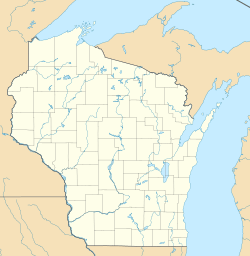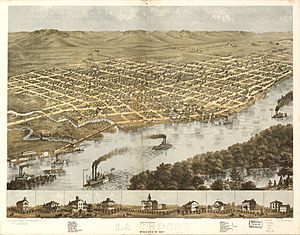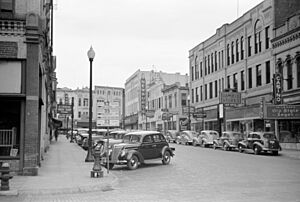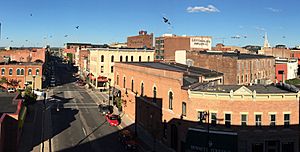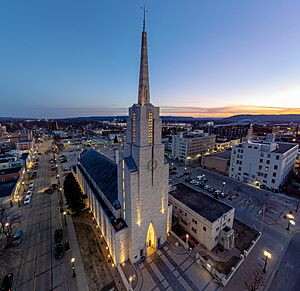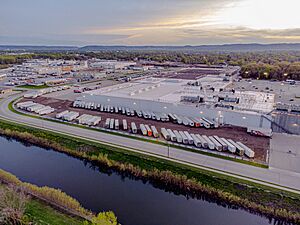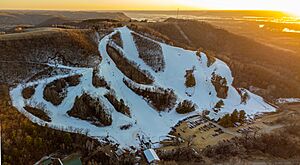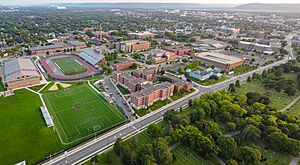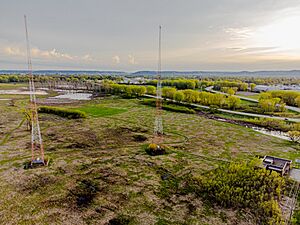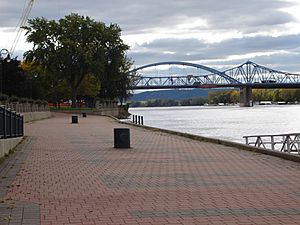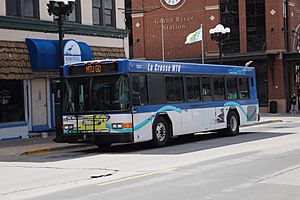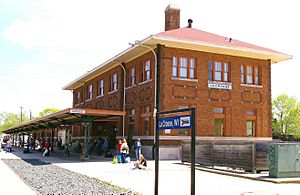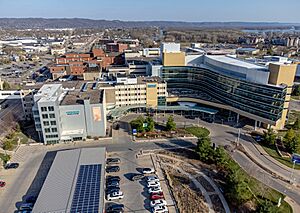La Crosse, Wisconsin facts for kids
Quick facts for kids
La Crosse, Wisconsin
|
||
|---|---|---|
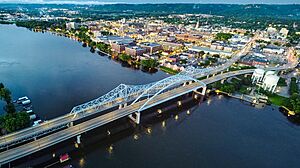
Downtown La Crosse
|
||
|
||
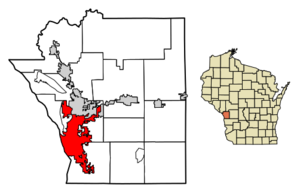
Location of La Crosse in La Crosse County, Wisconsin.
|
||
| Country | United States | |
| State | Wisconsin | |
| County | La Crosse | |
| Government | ||
| • Type | Mayor-council government | |
| Area | ||
| • City | 23.79 sq mi (61.61 km2) | |
| • Land | 21.70 sq mi (56.21 km2) | |
| • Water | 2.08 sq mi (5.40 km2) | |
| Elevation | 669 ft (204 m) | |
| Population
(2020)
|
||
| • City | 52,680 | |
| • Estimate
(2022)
|
51,380 |
|
| • Rank | US: 763rd WI: 12th |
|
| • Density | 2,214.38/sq mi (911.34/km2) | |
| • Urban | 98,872 (US: 314th) | |
| • Metro | 139,211 (US: 299th) | |
| Time zone | UTC−6 (Central) | |
| • Summer (DST) | UTC−5 (Central) | |
| Zip Code |
54601, 54602, 54603
|
|
| Area code | 608 | |
| FIPS code | 55-40775 | |
| GNIS feature ID | 1567672 | |
| Waterways | Mississippi River, Black River, La Crosse River | |
| Public Transit | La Crosse MTU SMRT Amtrak |
|
La Crosse (![]() i/ləˈkrɒs/ LƏ-kross) is a city in Wisconsin, United States. It is the main city of La Crosse County, Wisconsin. La Crosse is located right next to the famous Mississippi River. It is the biggest city on Wisconsin's western border.
i/ləˈkrɒs/ LƏ-kross) is a city in Wisconsin, United States. It is the main city of La Crosse County, Wisconsin. La Crosse is located right next to the famous Mississippi River. It is the biggest city on Wisconsin's western border.
In 2020, about 52,680 people lived in La Crosse. The city is the center of the La Crosse–Onalaska metropolitan area. This larger area includes parts of Wisconsin and Minnesota.
La Crosse is an important place for education, medicine, and making things. It also helps with transportation for Western Wisconsin. The city's economy was worth about $9.7 billion in 2022.
It's known as a college town because nearly 20,000 students live here. La Crosse is home to the University of Wisconsin–La Crosse, Viterbo University, and Western Technical College. Many big companies also have offices or headquarters here. These include Kwik Trip, Organic Valley, Mayo Clinic, and Trane. La Crosse County is a popular place for tourists, bringing in $433 million in 2023.
Contents
History of La Crosse
Early European Visits (18th Century)
The first Europeans to see this area were French fur traders. They traveled along the Mississippi River in the late 1600s. We don't have written records of anyone visiting until 1805. That's when Lt. Zebulon Pike explored the Mississippi River for the United States. Pike wrote down the name of the place as "Prairie La Crosse." This name came from a game played by Native Americans. They used sticks that looked like a bishop's crozier, which is called la crosse in French.
Settlement and Growth (19th Century)
In 1841, Nathan Myrick from New York started the first white settlement in La Crosse. He wanted to work in the fur trade. Since there were no spots in another town, he decided to open a trading post at Prairie La Crosse. In 1841, he built a temporary post on Barron Island. The next year, he moved the post to the mainland.
Myrick chose a great spot for a town. It was near where the Black, La Crosse, and Mississippi Rivers meet. Also, it was one of the few flat areas along the Wisconsin side of the Mississippi. A small village quickly grew around Myrick's trading post in the 1840s.
In 1844, a small group of Mormon settlers came to La Crosse. They built cabins a few miles south of Myrick's post. These settlers left after only a year. But the land they lived on is still called Mormon Coulee today. In 1850, the first Christian church service was held on top of Grandad Bluff. A monument there now marks this event.
More buildings like stores, a hotel, and a post office appeared in the 1840s. In 1851, the village was officially mapped out. This helped more people move there quickly. By 1855, La Crosse had almost 2,000 residents. It became a city in 1856. The city grew even faster after 1858. This was when the La Crosse & Milwaukee Railroad was finished. It was the second railroad to connect Milwaukee to the Mississippi River.
In the second half of the 1800s, La Crosse became one of Wisconsin's biggest cities. It was a major center for the lumber industry. Logs from inside the state could float down the Black River to sawmills in the city. La Crosse also became known for brewing beer and other factories. These businesses liked the city's location near major transportation routes.
Modern Times (20th and 21st Centuries)
Around 1900, La Crosse became a center for education. Three colleges and universities were started between 1890 and 1912. Like many cities, La Crosse's population growth slowed down in the late 1900s. This was partly due to people moving to suburbs.
Since 1966, La Crosse's population has grown by about 10%. The city's area and services have grown much more. La Crosse is still the largest city on Wisconsin's western border. Its schools have helped it become a hub for technology and medicine. In 2016, the city's mayors apologized for past discrimination against African Americans.
Geography of La Crosse

La Crosse is on the western edge of Wisconsin. It sits on a wide, flat plain next to the Mississippi River. The Black River flows into the Mississippi north of the city. The La Crosse River also joins the Mississippi just north of downtown. This river widens into a marshland. This marsh divides the city into northern and southern parts.
The city covers about 23.79 square miles (61.61 square kilometers). Most of this is land, with about 2.08 square miles (5.40 square kilometers) being water.
Tall bluffs surround the flat valley where La Crosse is. These bluffs are about 500 feet (152 meters) high. One of the most famous is Grandad Bluff. It offers amazing views of Wisconsin, Minnesota, and Iowa. This area is part of the Driftless Area. This region has high ridges and narrow valleys called coulees. Because of this, the area around La Crosse is often called the "Coulee Region."
Climate in La Crosse
La Crosse has a temperate, continental climate. This means it has four distinct seasons. July is the warmest month. The average high temperature is about 85.4°F (29.7°C). Overnight lows average 64.5°F (18.1°C). January is the coldest month. High temperatures average 27.4°F (-2.6°C). Overnight lows are around 10.5°F (-11.9°C).
| Climate data for La Crosse Regional Airport, Wisconsin (1991–2020 normals, extremes 1872–present) | |||||||||||||
|---|---|---|---|---|---|---|---|---|---|---|---|---|---|
| Month | Jan | Feb | Mar | Apr | May | Jun | Jul | Aug | Sep | Oct | Nov | Dec | Year |
| Record high °F (°C) | 57 (14) |
65 (18) |
84 (29) |
93 (34) |
107 (42) |
102 (39) |
108 (42) |
105 (41) |
101 (38) |
93 (34) |
80 (27) |
69 (21) |
108 (42) |
| Mean maximum °F (°C) | 45.8 (7.7) |
50.5 (10.3) |
67.7 (19.8) |
81.7 (27.6) |
89.1 (31.7) |
94.0 (34.4) |
95.2 (35.1) |
93.3 (34.1) |
89.9 (32.2) |
81.5 (27.5) |
64.3 (17.9) |
49.5 (9.7) |
97.3 (36.3) |
| Mean daily maximum °F (°C) | 27.4 (−2.6) |
32.5 (0.3) |
45.6 (7.6) |
59.6 (15.3) |
72.0 (22.2) |
81.7 (27.6) |
85.4 (29.7) |
83.2 (28.4) |
75.5 (24.2) |
61.6 (16.4) |
45.8 (7.7) |
32.6 (0.3) |
58.6 (14.8) |
| Daily mean °F (°C) | 18.9 (−7.3) |
23.3 (−4.8) |
35.8 (2.1) |
49.0 (9.4) |
61.0 (16.1) |
71.0 (21.7) |
75.0 (23.9) |
72.8 (22.7) |
64.8 (18.2) |
51.7 (10.9) |
37.6 (3.1) |
25.1 (−3.8) |
48.8 (9.3) |
| Mean daily minimum °F (°C) | 10.5 (−11.9) |
14.2 (−9.9) |
26.0 (−3.3) |
38.4 (3.6) |
50.1 (10.1) |
60.4 (15.8) |
64.5 (18.1) |
62.3 (16.8) |
54.1 (12.3) |
41.9 (5.5) |
29.5 (−1.4) |
17.6 (−8.0) |
39.1 (3.9) |
| Mean minimum °F (°C) | −13.8 (−25.4) |
−8.8 (−22.7) |
2.1 (−16.6) |
22.7 (−5.2) |
34.5 (1.4) |
45.7 (7.6) |
52.9 (11.6) |
50.3 (10.2) |
38.1 (3.4) |
26.2 (−3.2) |
12.3 (−10.9) |
−5.9 (−21.1) |
−17.3 (−27.4) |
| Record low °F (°C) | −43 (−42) |
−36 (−38) |
−28 (−33) |
7 (−14) |
26 (−3) |
33 (1) |
44 (7) |
35 (2) |
24 (−4) |
6 (−14) |
−21 (−29) |
−37 (−38) |
−43 (−42) |
| Average precipitation inches (mm) | 1.25 (32) |
1.19 (30) |
2.04 (52) |
3.75 (95) |
4.33 (110) |
5.08 (129) |
4.23 (107) |
3.90 (99) |
3.63 (92) |
2.49 (63) |
1.85 (47) |
1.49 (38) |
35.23 (895) |
| Average snowfall inches (cm) | 11.8 (30) |
9.7 (25) |
7.3 (19) |
2.9 (7.4) |
0.0 (0.0) |
0.0 (0.0) |
0.0 (0.0) |
0.0 (0.0) |
0.0 (0.0) |
0.3 (0.76) |
3.4 (8.6) |
10.9 (28) |
46.3 (118) |
| Average precipitation days (≥ 0.01 in) | 10.2 | 8.5 | 9.9 | 12.2 | 13.3 | 11.8 | 10.1 | 9.4 | 9.6 | 9.2 | 8.9 | 9.8 | 122.9 |
| Average snowy days (≥ 0.1 in) | 8.6 | 7.2 | 4.5 | 2.0 | 0.0 | 0.0 | 0.0 | 0.0 | 0.0 | 0.3 | 3.2 | 7.5 | 33.3 |
| Average relative humidity (%) | 72.8 | 72.2 | 70.6 | 64.2 | 65.0 | 69.5 | 72.1 | 75.2 | 77.2 | 71.3 | 75.4 | 77.3 | 71.9 |
| Average dew point °F (°C) | 7.5 (−13.6) |
12.0 (−11.1) |
23.4 (−4.8) |
34.0 (1.1) |
45.9 (7.7) |
56.7 (13.7) |
62.6 (17.0) |
61.0 (16.1) |
53.1 (11.7) |
39.9 (4.4) |
27.9 (−2.3) |
14.7 (−9.6) |
36.6 (2.5) |
| Source: NOAA (relative humidity and dew point 1961–1990) | |||||||||||||
Neighborhoods and Districts
La Crosse has 13 voting districts, also called wards. Some of the neighborhoods in the city include:
- Bluffside
- Washburn
- Historic Cass & King
- Powell-Poage-Hamilton
- Historic downtown
- Northside (Upper and Lower) and Old Towne North
- Grandview Emerson
- Weigent Hogan
- Hintgen
- College Park (where UW–La Crosse campus is)
- Springbrook Clayton Johnson
People of La Crosse (Demographics)
| Historical population | |||
|---|---|---|---|
| Census | Pop. | %± | |
| 1860 | 3,860 | — | |
| 1870 | 7,785 | 101.7% | |
| 1880 | 14,505 | 86.3% | |
| 1890 | 25,000 | 72.4% | |
| 1900 | 28,895 | 15.6% | |
| 1910 | 30,417 | 5.3% | |
| 1920 | 30,421 | 0.0% | |
| 1930 | 39,614 | 30.2% | |
| 1940 | 42,707 | 7.8% | |
| 1950 | 47,535 | 11.3% | |
| 1960 | 47,258 | −0.6% | |
| 1970 | 50,286 | 6.4% | |
| 1980 | 48,347 | −3.9% | |
| 1990 | 51,140 | 5.8% | |
| 2000 | 51,818 | 1.3% | |
| 2010 | 51,320 | −1.0% | |
| 2020 | 52,680 | 2.7% | |
| 2021 (est.) | 51,380 | 0.1% | |
| U.S. Decennial Census 2020 Census |
|||
2020 Census Information
In 2020, the population of La Crosse was 52,680 people. About 85.6% of the people were White. Other groups included 4.9% Asian, 2.9% Black or African American, and 0.5% Native American. About 3.2% of the population was Hispanic or Latino.
The average income for a family in the city was about $66,928. About 22.9% of the population lived below the poverty line. This included 13.6% of those under 18 years old. Most adults (93.9%) had graduated from high school or higher. Also, 36.5% had a bachelor's degree or more.
Hmong Community
- Further information: Hmong in Wisconsin
In 2022, there were about 1,435 Hmong people living in La Crosse. This group makes up about 60% of the city's Asian population.
Religious Groups in La Crosse
La Crosse has many different religious groups. These include Catholicism, Protestantism, Anglicanism, Eastern Orthodox, Judaism, Unitarian Universalism, and Islam.
La Crosse is home to the main church for the Roman Catholic Diocese of La Crosse. This church is called the Cathedral of Saint Joseph the Workman. The city also has St. Rose of Viterbo Convent, which is the main house for the Franciscan Sisters of Perpetual Adoration. Another important Catholic site is the Shrine of Our Lady of Guadalupe.
Many Protestant churches are in the city. These include Lutheran, Evangelical, Baptist, Methodist, and Presbyterian churches. The Wisconsin Evangelical Lutheran Synod has five churches in La Crosse. Christ Church of La Crosse, an Episcopal church, is a historic building. St. Elias Antiochian Orthodox Church is also a historic site.
Other religious groups include the Congregation Sons of Abraham, a Jewish synagogue. The Unitarian Universalist Fellowship of La Crosse has been holding services since 1951. There is also the Islamic Society Othman Bin Afaan and the Hmong Faith Alliance Church.
Economy and Jobs
La Crosse is home to the main offices of several companies and groups. Some of these include:
- Allergy Associates of La Crosse, a national allergy clinic.
- Altra Federal Credit Union, a regional bank.
- City Brewing Company, a brewery.
- Gundersen Health System, a large healthcare network.
- Kwik Trip, a chain of gas and convenience stores.
- La Crosse Technology, which makes radio-controlled clocks and weather stations.
- Marine Credit Union, another regional bank.
Some well-known companies were started in La Crosse, even if their main offices are now elsewhere. These include Cargill, which is now America's largest private company. Also, La Croix Sparkling Water was first made here. Trane, a big air conditioning company, was also founded in La Crosse.
Top Employers
As of 2012, the biggest employers in La Crosse were:
- Gundersen Health System
- Mayo Clinic Health System
- Trane
- Kwik Trip
- La Crosse County
- School District of La Crosse
- University of Wisconsin–La Crosse
- Logistics Health Incorporated
- City of La Crosse
- Western Technical College
Shopping in La Crosse
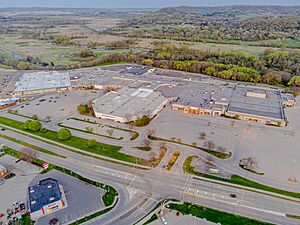
La Crosse is a shopping center for the region. The largest shopping mall, Valley View Mall, is in the northeastern part of the city. This area also has many large stores and restaurants.
Downtown La Crosse has become popular again. It offers unique shops, farmers' markets, hotels, and restaurants.
Arts and Culture
La Crosse has more than 30 active arts groups. The Pump House Regional Arts Center shows art and hosts music concerts. The La Crosse Symphony is the city's orchestra. The La Crosse Community Theater has won awards. The city is also home to the Blue Stars Drum and Bugle Corps.
Other places for arts include Viterbo University's Fine Arts building and the UW–La Crosse Art Gallery. The La Crosse Center hosts big concerts and shows. Local artist Elmer Petersen has sculptures downtown, like La Crosse Players and the Eagle. The city also has a yearly St. Patrick's Day Parade and Irishfest La Crosse.
The La Crosse Center is a large building downtown by the Mississippi River. It hosts sports events, concerts, and shows. Every year, the city celebrates Oktoberfest USA. This celebration started in 1961.
Parks and Fun Activities
Sports in La Crosse
The La Crosse Loggers baseball team and La Crosse Steam softball team play at Copeland Park in the summer. The La Crosse Showtime basketball team started playing at the La Crosse Center in 2017. In the past, the La Crosse Center hosted other sports teams like the Catbirds and Bobcats basketball teams.
In winter, you can ski at Mt. La Crosse. It opened in 1959 and has 19 slopes. One slope, Damnation!, is the steepest in the Midwest.
The University of Wisconsin–La Crosse's sports teams are called the Eagles. They compete in NCAA Division III. Their Veterans Memorial Field opened in 2009. It hosts high school track and field championships.
The La Crosse Fairgrounds Speedway is nearby in West Salem. It is Wisconsin's only paved NASCAR-approved race track.
Parks in La Crosse
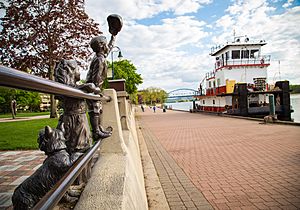
Riverside Park is downtown by the river. It's a popular spot for events like Riverfest and Oktoberfest. Steamboats like the American Queen stop here. The park has paths for walking and running. A statue called A Simpler Time is also in the park.
Pettibone Park is on Barron Island, across the river. This island used to be part of Minnesota. It became part of Wisconsin in 1919. Today, the park has a beach and a disc golf course.
A large marsh (wetland) divides the city. This marsh is a natural floodplain created by the La Crosse River. It's protected because it's important for wildlife and the Mississippi River. There are biking and walking paths through the marsh. People also go canoeing, fishing, and trapping here.
Myrick Park is at the southern end of the marsh. It's named after Nathan Myrick, the city's first European settler. The park has many fun things to do. It also has a nature center for learning about the environment. Hunting and fishing are very popular in the area. The Mississippi River and other waterways offer many places for outdoor activities.
Education in La Crosse
The School District of La Crosse serves the area. In 2022, it had over 6,100 students. The district has 16 buildings and offers 20 different school programs.
There are also private schools in La Crosse. La Crosse Aquinas Catholic Schools is a Catholic school district. It includes Aquinas High School and Aquinas Middle School. The Providence Academy is another Catholic school.
Lutheran private schools include First Lutheran School and Immanuel Lutheran School. These are part of the La Crosse Area Lutheran Schools. The biggest Lutheran high school, Luther High School, is in nearby Onalaska, Wisconsin.
La Crosse has three colleges and universities:
- The University of Wisconsin–La Crosse is a public university.
- Western Technical College is a public community college.
- Viterbo University is a private Catholic university.
The Health Science Center helps students prepare for medical careers. It's a team effort by the medical centers, universities, and government groups in La Crosse.
Media in La Crosse
Newspapers and Magazines
La Crosse's main newspaper is the daily La Crosse Tribune. It serves Wisconsin, Minnesota, and Iowa. The Racquet is a free weekly paper from the University of Wisconsin–La Crosse. There are also free weekly tabloids like the Foxxy Shopper. Regional magazines like Coulee Parenting Connection are also made in the city.
Television Stations
| Channel | Callsign | Affiliation | Branding | Subchannels | |
|---|---|---|---|---|---|
| (Virtual) | Channel | Programming | |||
| 8.1 | WKBT KQEG-CD |
CBS | WKBT 8 | 8.2 8.3 8.4 8.5 8.6 |
MyNetworkTV ION Dabl QVC HSN |
| 14.1 | W34FC-D | CW | La Crosse/Eau Claire CW | 14.2 14.3 14.4 13.10 |
Heroes & Icons Start TV MeTV NBC (WEAU) |
| 19.1 | WXOW | ABC | WXOW 19 | 19.2 19.3 19.4 19.5 |
Decades This TV Court TV Justice Network |
| 25.1 | WLAX | FOX | FOX 25/48 | 25.2 25.3 25.4 |
Antenna TV Laff Grit |
| 26.1 | WZEO-LD | Buzzr | |||
| 31.1 | WHLA | PBS | PBS Wisconsin | 31.2 31.3 31.4 |
Wisconsin Channel Create PBS Kids |
Radio Stations
La Crosse has many radio stations, both AM and FM. They play different kinds of music and talk shows. Some stations include:
- WKTY (580 AM) for sports.
- WIZM (1410 AM) for news and talk.
- WLCX (1490 AM) for news and talk.
- WIZM-FM (93.3 FM) for Top 40 music.
- WTMB (94.5 FM) for classic rock.
- WRQT (95.7 FM) for rock music.
- WCOW-FM (97.1 FM) for country music.
City Infrastructure
Transportation
Airport
The La Crosse Regional Airport (KLSE) is on French Island. It has flights to Chicago with American Airlines. Other airlines offer special charter flights to places like Laughlin, Nevada. The airport also serves smaller private planes.
Roads
Several major highways and an Interstate serve the city. These include Interstate 90, U.S. Highway 14, U.S. Highway 53, and U.S. Highway 61.
The Mississippi River Bridge (also called the Cass St. bridge) and the newer Cameron Street bridge connect downtown La Crosse to La Crescent, Minnesota. These bridges cross the Mississippi River. Interstate 90 also has a bridge just northwest of La Crosse.
Walking and Cycling
In 2012, La Crosse was the first city in Wisconsin to pass a "Green Complete Streets" rule. This means that when roads are rebuilt, they must also plan for stormwater, bikes, and walkers. The city also made a Bicycle and Pedestrian Master Plan.
By 2018, La Crosse had about 7.7 miles (12.4 km) of bike lanes on streets. It also had 17.1 miles (27.5 km) of paved bike paths. In 2021, a new bikeshare system started downtown. It has grown each year, offering more bikes and stations.
The Mississippi River Trail goes through La Crosse. The La Crosse River Trail and the Great River State Trail also pass through the northern part of the city. These trails are built on old railroad lines.
Public Transit
Public transportation in La Crosse started in 1878 with horse-drawn streetcars. Later, these became electric. By 1945, buses replaced all the streetcars. The City of La Crosse took over the bus service in the 1970s.
Today, the La Crosse Municipal Transit Utility (MTU) runs 11 bus routes. Buses start early in the morning and run until late at night. A regional bus service, Scenic Mississippi Regional Transit, also connects La Crosse to other towns.
Railroads
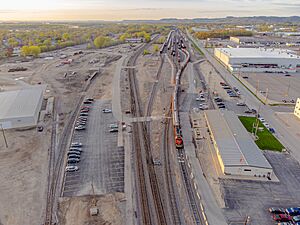
The first railroad came to La Crosse in 1858 from Milwaukee. Today, the Amtrak station is on this line. The Empire Builder train stops here daily, connecting Chicago to Seattle or Portland. In May 2024, a new train called Borealis also started service between Chicago and St. Paul.
Another railroad, Burlington Northern and Santa Fe Railway (BNSF), also passes through La Crosse. It carries freight.
Intercity Bus
Jefferson Lines has a daily bus service through La Crosse. It connects Minneapolis and Milwaukee. Badger Bus also offers service between Madison and Minneapolis on certain days during the school year. Both companies stop at the University of Wisconsin–La Crosse Student Union.
Waterways
On the Mississippi River, large boats called towboats move cargo. They mostly carry things like coal and grain to and from St. Paul and St. Louis. Lock and Dam No. 7 on the Mississippi River is about 4.5 miles (7.2 km) upstream from downtown La Crosse.
Utilities
La Crosse's drinking water comes from deep underground. In 2007, it won an award for the best-tasting natural water in Wisconsin. The water is treated with chlorine and fluoride.
Recently, chemicals called PFAS were found in the groundwater on French Island, WI. This happened because of firefighting foam used at the La Crosse Regional Airport. Two city wells had to be closed. Some private wells in the nearby town of Campbell, WI are also unsafe to use. The state of Wisconsin has given bottled water to affected residents.
Healthcare
La Crosse has two major healthcare centers: Gundersen Health System and the Franciscan Skemp Medical Center.
Gundersen Health System is a top-ranked healthcare system. It is a Level II Trauma Center, meaning it can handle serious injuries. It is also the main hospital for the Gundersen Clinic. Gundersen Health has its main campus in La Crosse. It also manages 23 other locations in Wisconsin, Minnesota, and Iowa.
The Franciscan Skemp Medical Center is part of the Mayo Clinic. It was first opened in 1883 as St. Francis Hospital. It was started by the Catholic Franciscan Sisters of Perpetual Adoration. In 1995, it joined with Mayo Clinic Health Systems. A new emergency department and surgery wing opened in 2007.
The Health Science Center is on the University of Wisconsin–La Crosse campus. It is a joint effort by the medical centers, universities, and government groups. Its goal is to train students for jobs in the medical field.
Notable People
Sister Cities
La Crosse has special "sister city" relationships with seven cities around the world:
 Bantry, Ireland
Bantry, Ireland Dubna, Russia
Dubna, Russia Épinal, France
Épinal, France Friedberg, Germany
Friedberg, Germany Førde, Norway
Førde, Norway Junglinster, Luxembourg
Junglinster, Luxembourg Kumbo, Cameroon
Kumbo, Cameroon Luoyang, China
Luoyang, China
See also
 In Spanish: La Crosse (Wisconsin) para niños
In Spanish: La Crosse (Wisconsin) para niños



